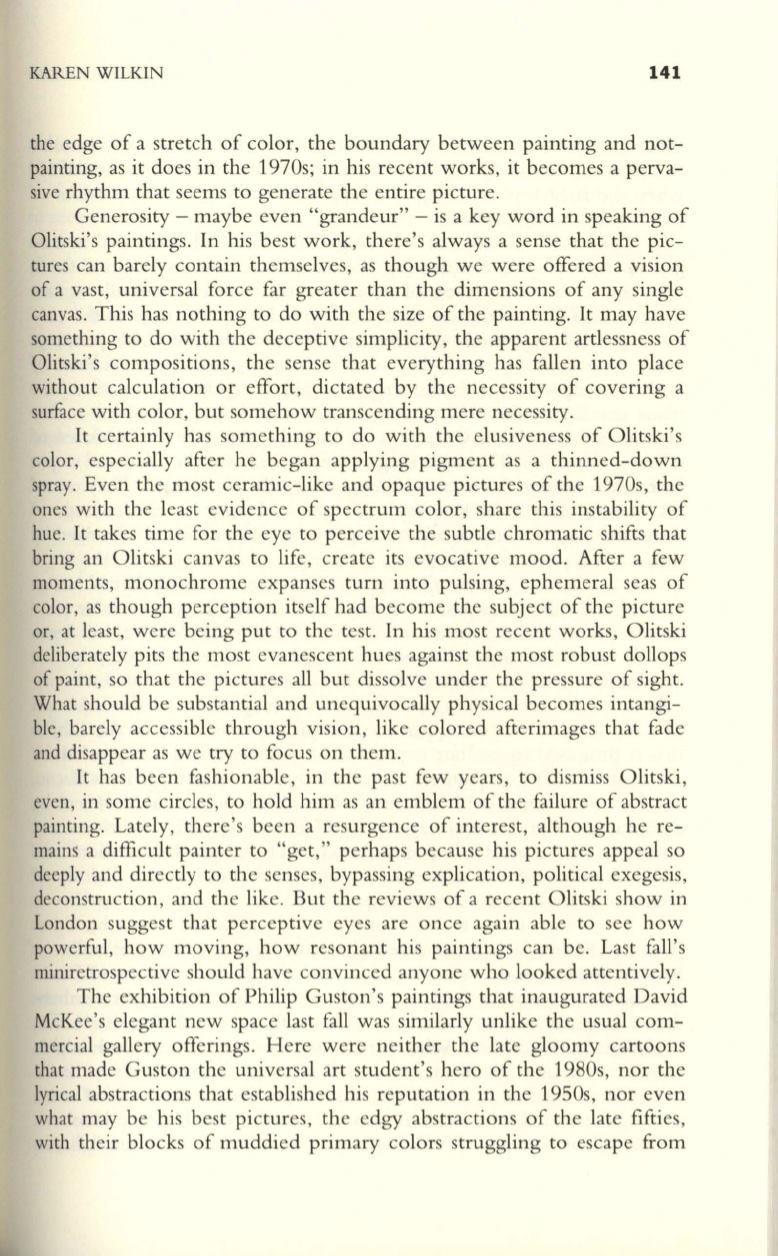
KAREN WILKIN
141
the edge of a stretch of color, the boundary between painting and not–
painting, as it does in the 1970s; in his recent works, it becomes a perva–
sive rhythm that seems to generate the entire picture.
Generosity - maybe even "grandeur" - is a key word in speaking of
Olitski's paintings. In his best work, there's always a sense that the pic–
tures can barely contain themselves, as though we were offered a vision
of a vast, universal force far greater than the dimensions of any single
canvas. This has nothing to do with the size of the painting. It may have
something to do with the deceptive simplicity, the apparent artlessness of
Olitski's compositions, the sense that everything has fallen into place
without calculation or effort, dictated by the necessity of covering a
surface with color, but somehow transcending mere necessity.
It
certainly has something to do with the elusiveness of Olitski's
color, especially after he began applying pigment as a thinned-down
spray. Even the most ceramic-like and opaque pictures of the 1970s, the
ones with the least evidence of spectrum color, share this instability of
hue. It takes time for the eye to perceive the subtle chromatic shifts that
bring an Olitski canvas to life, create its evocative mood. After a few
moments, monochrome expanses turn into pulsing, ephemeral seas of
color, as though perception itself had become the subject of the picture
or, at least, were being put to the test. In his most recent works, Olitski
deliberately pits the most evanescent hues against the most robust dollops
of paint, so that the pictures all but dissolve under the pressure of sight.
What should be substantial and unequivocally physical becomes intangi–
ble, barely accessible through vision, like colored afterimages that fade
and disappear as we try to focus on them.
It has been fashionable, in the past few years, to dismiss Olitski,
even, in some circles, to hold him as an emblem of the failure of abstract
painting. Lately, there's been a resurgence of interest, although he re–
mains a difficult painter to "get," perhaps because his pictures appeal so
deeply and directly to the senses, bypassing explication, political exegesis,
deconstruction, and the like. But the reviews of a recent Olitski show in
London suggest that perceptive eyes are once again able to see how
powerful, how moving, how resonant his paintings can be. Last fall's
miniretrospective should have convinced anyone who looked attentively.
The exhibition of Philip Guston's paintings that inaugurated David
McKee's elegant new space last fall was similarly unlike the usual com–
mercial gallery offerings. Here were neither the late gloomy cartoons
that made Guston the universal art student's hero of the 1980s, nor the
lyrical abstractions that established his reputation in the 1950s, nor even
what may be his best pictures, the edgy abstractions of the late fifties,
with their blocks of muddied primary colors struggling to escape from


